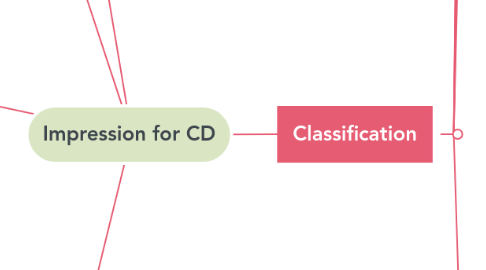
1. Basic Principles of Impression Making
1.1. Gross anatomy
1.1.1. Impression must cover the maximum amount of tissues
1.1.2. peripheral seal should be recorded without interference
1.1.3. Must record the intimate detail
1.2. Microscopic anatomy
1.2.1. How soft tissues and bones respond to pressure
1.2.2. Closely Attached soft tissue better to support than those with loosely attachment
1.2.3. Thicker submucosal tissues may be displaced more than thin tissues
2. Objectives of Impressions
2.1. Retention
2.1.1. Resistance to removal in a direction opposite that of its insertion
2.1.2. Resists the force of gravity, adhesiveness of food
2.2. Stability
2.2.1. quality of a denture to be firm, steady and constant when force are applied
2.2.2. Resistance to horizontal forces and movement
2.3. Support
2.3.1. resistance to vertical components of mastication
2.3.2. Resistance forces applied in a direction toward the basal seat
2.3.3. Should provide maximum coverage
2.4. Esthetics
2.4.1. appearance of the patient
2.5. Preservation of Residual Ridge
2.5.1. All phases of denture construction will influence the preservation of existing ridges
3. Requirements Of An Ideal Impression Material
3.1. No dimensional change
3.2. Viscus enough
3.3. Suitable working and seating Time
3.4. Accurate
3.5. Good tear strength
3.6. Easy to mix
3.7. Cost effective
3.8. Long shelf life
4. Impression landmarks
4.1. Mandible
4.1.1. Labial frenulum notch
4.1.2. Labial vestibule
4.1.3. Buccal frenal notch
4.1.4. Buccaneers vestibule
4.1.5. Buccaneers shelf
4.1.6. Retromolar pad
4.1.7. Retromylohyoid sulcus
4.1.8. Anterior lingual sulcus
4.1.9. Lingual frenal notch
4.1.10. Edentulous ridg
4.2. Maxillary
4.2.1. Labial frenulum notch
4.2.2. Labial vestibule
4.2.3. Buccal frenal notch
4.2.4. Buccal vestibule
4.2.5. Tuberosity sulcus
4.2.6. Hamular notch
4.2.7. Fovea palatine
4.2.8. Edentulous ridge
4.2.9. Incisive papilla
4.2.10. Tuberosity
4.2.11. Rugea
4.2.12. Median suture
5. Classification
5.1. According to Prosthodontic Use
5.1.1. Primary impressions
5.1.1.1. Taken by the dentist
5.1.1.2. make reproduction of the teeth and surrounding tissues
5.1.1.3. Used to make:
5.1.1.3.1. diagnostic cast
5.1.1.3.2. custom trays
5.1.1.4. Alginate , impression compound
5.1.2. Final impression
5.1.2.1. Taken by the dentist
5.1.2.2. Taken by the dentist
5.1.2.3. make the most accurate reproduction of the teeth and surrounding
5.1.2.4. Used to make:
5.1.2.4.1. Master cast
5.1.2.5. Alginate , agar, elastomers, ZOE
5.1.3. Bite registration
5.1.3.1. Taken by dentist/dental assistant
5.1.3.2. Make a reproduction of the occlusal relationship between the maxillary and the mandibular teeth
5.1.3.3. Provide accurate registration of patient’s centric relationship
5.1.3.4. Waxes, elastomers, ZOE
5.2. According to Boucher
5.2.1. Arbitrary impression
5.2.1.1. using the anatomic impression structures
5.2.2. Anatomic impression
5.2.2.1. FUNCTIONAL MOVEMENT of the anatomical structure
5.3. Based on the position of the mouth while during making the impression
5.3.1. Open mouth
5.3.1.1. IMPRESSIONIS HELD BY DENTIST
5.3.1.2. MINIMUM PRESSURE
5.3.2. Closed mouth
5.4. Based on the theories of impression
5.4.1. Pressure theory (Supportive form)
5.4.1.1. under functional pressure(closed mouth technique)
5.4.1.2. impression should be made using closely-fitting custom trays with no stops
5.4.1.3. Impression compound is used
5.4.1.4. excessive pressure may lead bone resorption
5.4.1.5. Better retention and support during function
5.4.2. Minimal pressure theory (Anatomic form)
5.4.2.1. cover only those areas of the denture foundation where the mucosa is firmly attached
5.4.2.2. maintained in an undisplaced form..
5.4.2.3. Shorter flanges
5.4.2.4. Based on Pascals Lawof Hydrostatics
5.4.2.5. impression material of low viscosity and high properties is selected,
5.4.3. Selective pressure theory
5.4.3.1. Combines of both pressure and minimal
5.4.3.2. adapted by nature for withstanding extra loads from forces of mastication.
5.4.3.3. tissue will be recorded in a relaxed undistorted state and other with definite amount of pressure
5.4.3.4. Most popular
5.5. Based on the method of manipulation
5.5.1. Hand manipulation
5.5.2. Functional movements
5.6. according to Elastic properties and chemical type
5.6.1. Elastic
5.6.1.1. Non aqueous Elastomers
5.6.1.1.1. Polysulfide
5.6.1.1.2. Polyether
5.6.1.1.3. Condensation silicon
5.6.1.1.4. Addition silicone
5.6.1.2. Hydrocolloids
5.6.1.2.1. Agar (Reversible)(Hydrophillic)
5.6.1.2.2. Alginate (Irreversible)(Hydrophillic)
5.6.2. Non Elastic
5.6.2.1. Plaster
5.6.2.1.1. Chemical reaction
5.6.2.2. ZOE
5.6.2.2.1. Chemical reaction
5.6.2.2.2. Properties
5.6.2.2.3. composition
5.6.2.3. impression compound
5.6.2.3.1. Cooling to mouth temperature It cools at 37C
5.6.2.3.2. thermoplastic
5.6.2.3.3. Have properties similar to dental wax
5.6.2.3.4. ADV
5.6.2.3.5. DisADV
5.6.2.3.6. Types
5.6.2.3.7. Properties
5.6.2.4. Impression wax
5.6.2.4.1. Temperature changes
